Criminology Assignment: Analyzing Key Theories and Concepts
VerifiedAdded on 2022/09/28
|6
|1045
|25
Homework Assignment
AI Summary
This criminology assignment explores several key theories and concepts within the field. It begins by introducing Albert K. Cohen's subcultural theory, focusing on delinquent gangs, and then discusses differential opportunity theory, highlighting how individuals in low socioeconomic situations may utilize available resources. The assignment then examines Ferracuti and Wolfgang's work on subcultures of violence, followed by an overview of social control theory and Travis Hirschi's contributions. It also covers Walter Reckless's containment theory and John Bowlby's attachment theory. Additionally, it explains reaction formation psychology and the neutralization/drift theory proposed by Matza and Sykes, and concludes with a discussion of the rational choice theory in criminology. The assignment references relevant academic sources to support the presented theories.
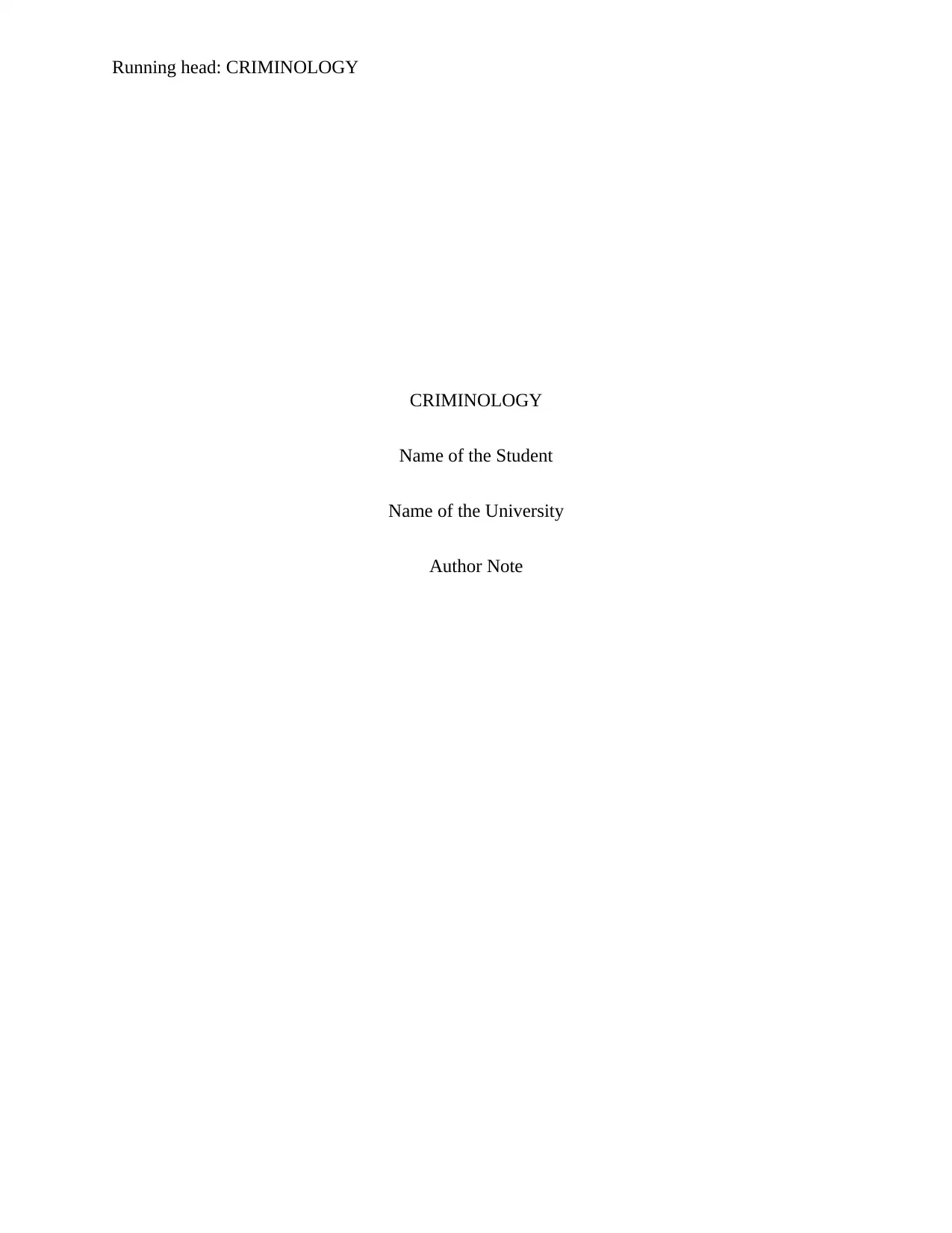
Running head: CRIMINOLOGY
CRIMINOLOGY
Name of the Student
Name of the University
Author Note
CRIMINOLOGY
Name of the Student
Name of the University
Author Note
Paraphrase This Document
Need a fresh take? Get an instant paraphrase of this document with our AI Paraphraser
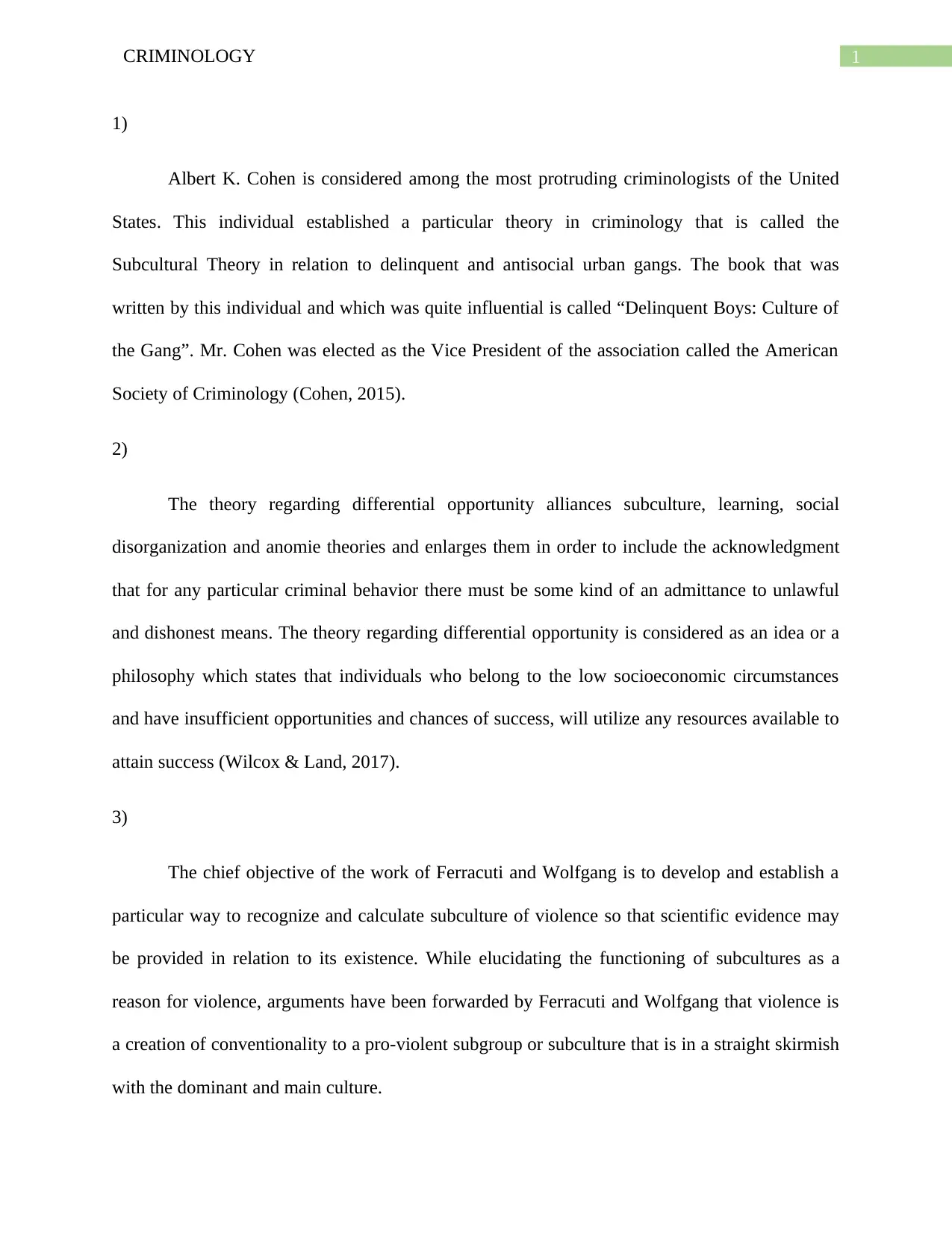
1CRIMINOLOGY
1)
Albert K. Cohen is considered among the most protruding criminologists of the United
States. This individual established a particular theory in criminology that is called the
Subcultural Theory in relation to delinquent and antisocial urban gangs. The book that was
written by this individual and which was quite influential is called “Delinquent Boys: Culture of
the Gang”. Mr. Cohen was elected as the Vice President of the association called the American
Society of Criminology (Cohen, 2015).
2)
The theory regarding differential opportunity alliances subculture, learning, social
disorganization and anomie theories and enlarges them in order to include the acknowledgment
that for any particular criminal behavior there must be some kind of an admittance to unlawful
and dishonest means. The theory regarding differential opportunity is considered as an idea or a
philosophy which states that individuals who belong to the low socioeconomic circumstances
and have insufficient opportunities and chances of success, will utilize any resources available to
attain success (Wilcox & Land, 2017).
3)
The chief objective of the work of Ferracuti and Wolfgang is to develop and establish a
particular way to recognize and calculate subculture of violence so that scientific evidence may
be provided in relation to its existence. While elucidating the functioning of subcultures as a
reason for violence, arguments have been forwarded by Ferracuti and Wolfgang that violence is
a creation of conventionality to a pro-violent subgroup or subculture that is in a straight skirmish
with the dominant and main culture.
1)
Albert K. Cohen is considered among the most protruding criminologists of the United
States. This individual established a particular theory in criminology that is called the
Subcultural Theory in relation to delinquent and antisocial urban gangs. The book that was
written by this individual and which was quite influential is called “Delinquent Boys: Culture of
the Gang”. Mr. Cohen was elected as the Vice President of the association called the American
Society of Criminology (Cohen, 2015).
2)
The theory regarding differential opportunity alliances subculture, learning, social
disorganization and anomie theories and enlarges them in order to include the acknowledgment
that for any particular criminal behavior there must be some kind of an admittance to unlawful
and dishonest means. The theory regarding differential opportunity is considered as an idea or a
philosophy which states that individuals who belong to the low socioeconomic circumstances
and have insufficient opportunities and chances of success, will utilize any resources available to
attain success (Wilcox & Land, 2017).
3)
The chief objective of the work of Ferracuti and Wolfgang is to develop and establish a
particular way to recognize and calculate subculture of violence so that scientific evidence may
be provided in relation to its existence. While elucidating the functioning of subcultures as a
reason for violence, arguments have been forwarded by Ferracuti and Wolfgang that violence is
a creation of conventionality to a pro-violent subgroup or subculture that is in a straight skirmish
with the dominant and main culture.
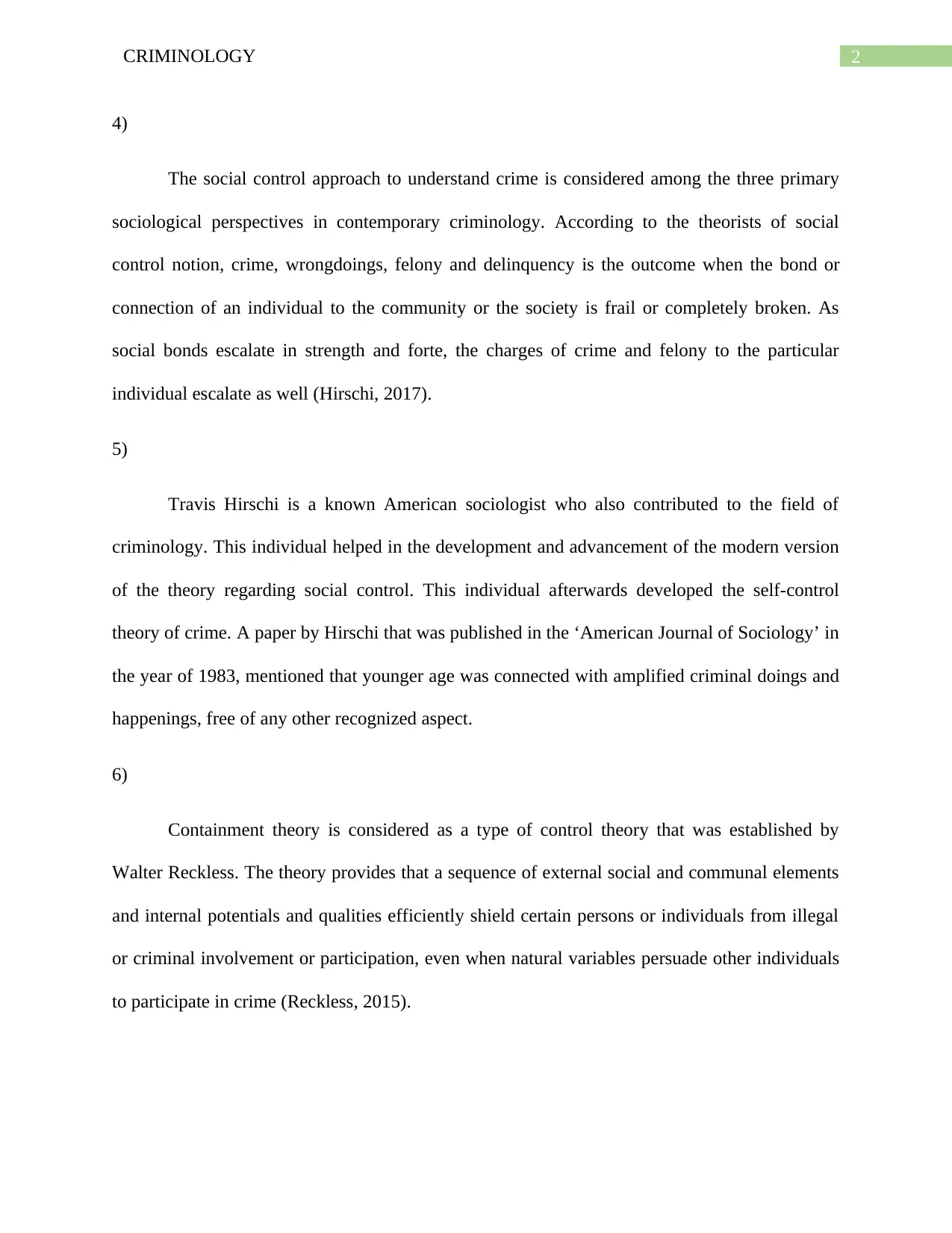
2CRIMINOLOGY
4)
The social control approach to understand crime is considered among the three primary
sociological perspectives in contemporary criminology. According to the theorists of social
control notion, crime, wrongdoings, felony and delinquency is the outcome when the bond or
connection of an individual to the community or the society is frail or completely broken. As
social bonds escalate in strength and forte, the charges of crime and felony to the particular
individual escalate as well (Hirschi, 2017).
5)
Travis Hirschi is a known American sociologist who also contributed to the field of
criminology. This individual helped in the development and advancement of the modern version
of the theory regarding social control. This individual afterwards developed the self-control
theory of crime. A paper by Hirschi that was published in the ‘American Journal of Sociology’ in
the year of 1983, mentioned that younger age was connected with amplified criminal doings and
happenings, free of any other recognized aspect.
6)
Containment theory is considered as a type of control theory that was established by
Walter Reckless. The theory provides that a sequence of external social and communal elements
and internal potentials and qualities efficiently shield certain persons or individuals from illegal
or criminal involvement or participation, even when natural variables persuade other individuals
to participate in crime (Reckless, 2015).
4)
The social control approach to understand crime is considered among the three primary
sociological perspectives in contemporary criminology. According to the theorists of social
control notion, crime, wrongdoings, felony and delinquency is the outcome when the bond or
connection of an individual to the community or the society is frail or completely broken. As
social bonds escalate in strength and forte, the charges of crime and felony to the particular
individual escalate as well (Hirschi, 2017).
5)
Travis Hirschi is a known American sociologist who also contributed to the field of
criminology. This individual helped in the development and advancement of the modern version
of the theory regarding social control. This individual afterwards developed the self-control
theory of crime. A paper by Hirschi that was published in the ‘American Journal of Sociology’ in
the year of 1983, mentioned that younger age was connected with amplified criminal doings and
happenings, free of any other recognized aspect.
6)
Containment theory is considered as a type of control theory that was established by
Walter Reckless. The theory provides that a sequence of external social and communal elements
and internal potentials and qualities efficiently shield certain persons or individuals from illegal
or criminal involvement or participation, even when natural variables persuade other individuals
to participate in crime (Reckless, 2015).
⊘ This is a preview!⊘
Do you want full access?
Subscribe today to unlock all pages.

Trusted by 1+ million students worldwide
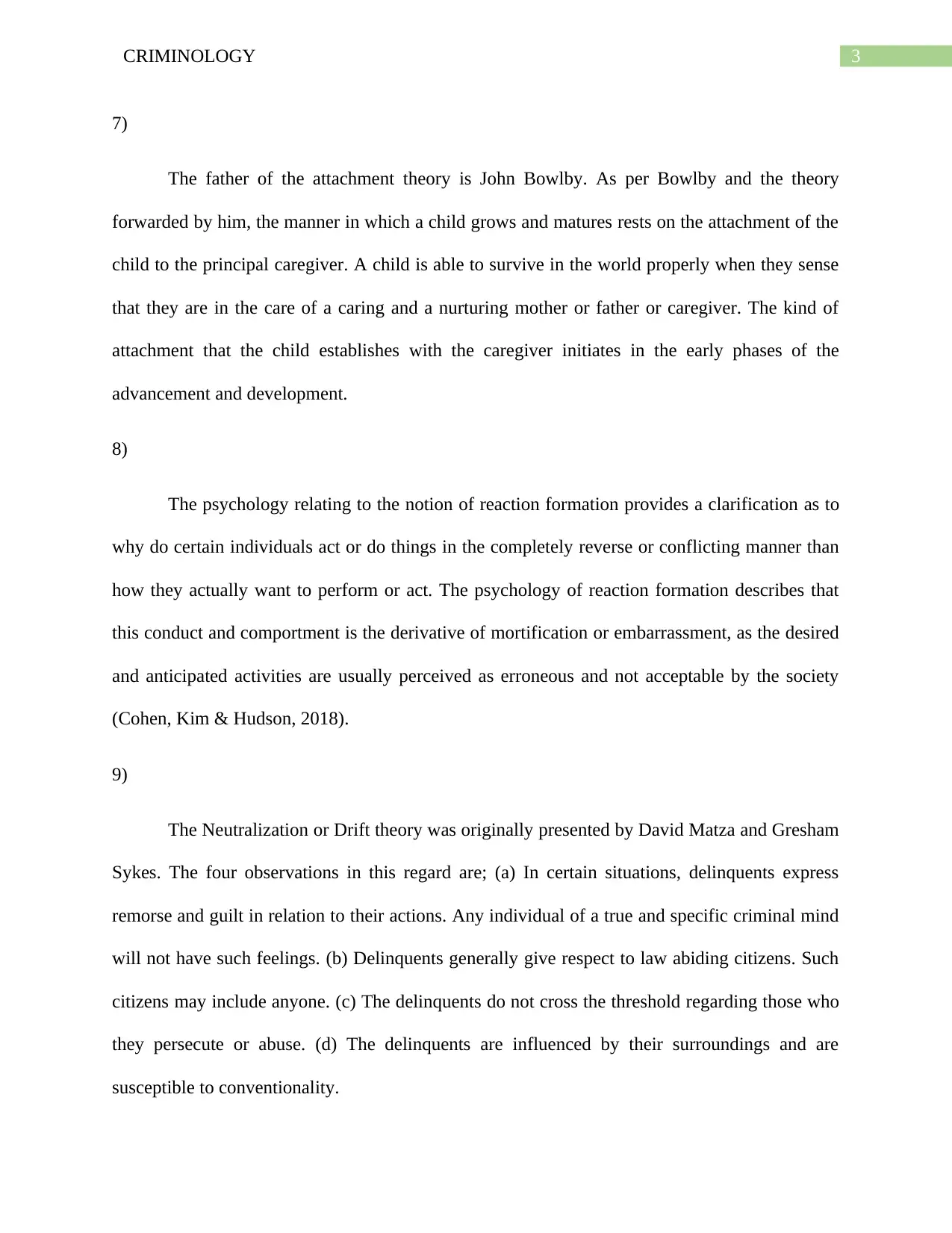
3CRIMINOLOGY
7)
The father of the attachment theory is John Bowlby. As per Bowlby and the theory
forwarded by him, the manner in which a child grows and matures rests on the attachment of the
child to the principal caregiver. A child is able to survive in the world properly when they sense
that they are in the care of a caring and a nurturing mother or father or caregiver. The kind of
attachment that the child establishes with the caregiver initiates in the early phases of the
advancement and development.
8)
The psychology relating to the notion of reaction formation provides a clarification as to
why do certain individuals act or do things in the completely reverse or conflicting manner than
how they actually want to perform or act. The psychology of reaction formation describes that
this conduct and comportment is the derivative of mortification or embarrassment, as the desired
and anticipated activities are usually perceived as erroneous and not acceptable by the society
(Cohen, Kim & Hudson, 2018).
9)
The Neutralization or Drift theory was originally presented by David Matza and Gresham
Sykes. The four observations in this regard are; (a) In certain situations, delinquents express
remorse and guilt in relation to their actions. Any individual of a true and specific criminal mind
will not have such feelings. (b) Delinquents generally give respect to law abiding citizens. Such
citizens may include anyone. (c) The delinquents do not cross the threshold regarding those who
they persecute or abuse. (d) The delinquents are influenced by their surroundings and are
susceptible to conventionality.
7)
The father of the attachment theory is John Bowlby. As per Bowlby and the theory
forwarded by him, the manner in which a child grows and matures rests on the attachment of the
child to the principal caregiver. A child is able to survive in the world properly when they sense
that they are in the care of a caring and a nurturing mother or father or caregiver. The kind of
attachment that the child establishes with the caregiver initiates in the early phases of the
advancement and development.
8)
The psychology relating to the notion of reaction formation provides a clarification as to
why do certain individuals act or do things in the completely reverse or conflicting manner than
how they actually want to perform or act. The psychology of reaction formation describes that
this conduct and comportment is the derivative of mortification or embarrassment, as the desired
and anticipated activities are usually perceived as erroneous and not acceptable by the society
(Cohen, Kim & Hudson, 2018).
9)
The Neutralization or Drift theory was originally presented by David Matza and Gresham
Sykes. The four observations in this regard are; (a) In certain situations, delinquents express
remorse and guilt in relation to their actions. Any individual of a true and specific criminal mind
will not have such feelings. (b) Delinquents generally give respect to law abiding citizens. Such
citizens may include anyone. (c) The delinquents do not cross the threshold regarding those who
they persecute or abuse. (d) The delinquents are influenced by their surroundings and are
susceptible to conventionality.
Paraphrase This Document
Need a fresh take? Get an instant paraphrase of this document with our AI Paraphraser
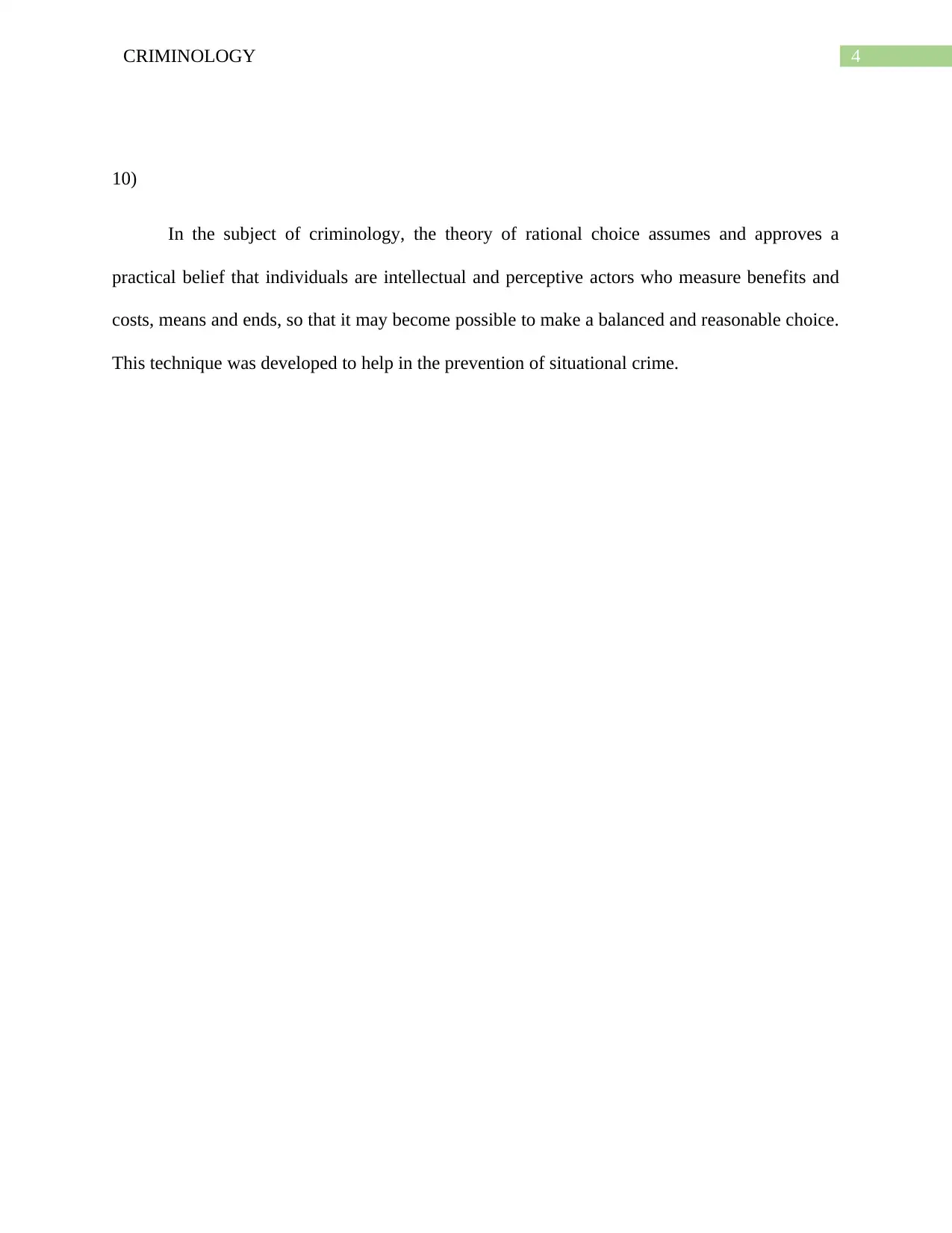
4CRIMINOLOGY
10)
In the subject of criminology, the theory of rational choice assumes and approves a
practical belief that individuals are intellectual and perceptive actors who measure benefits and
costs, means and ends, so that it may become possible to make a balanced and reasonable choice.
This technique was developed to help in the prevention of situational crime.
10)
In the subject of criminology, the theory of rational choice assumes and approves a
practical belief that individuals are intellectual and perceptive actors who measure benefits and
costs, means and ends, so that it may become possible to make a balanced and reasonable choice.
This technique was developed to help in the prevention of situational crime.
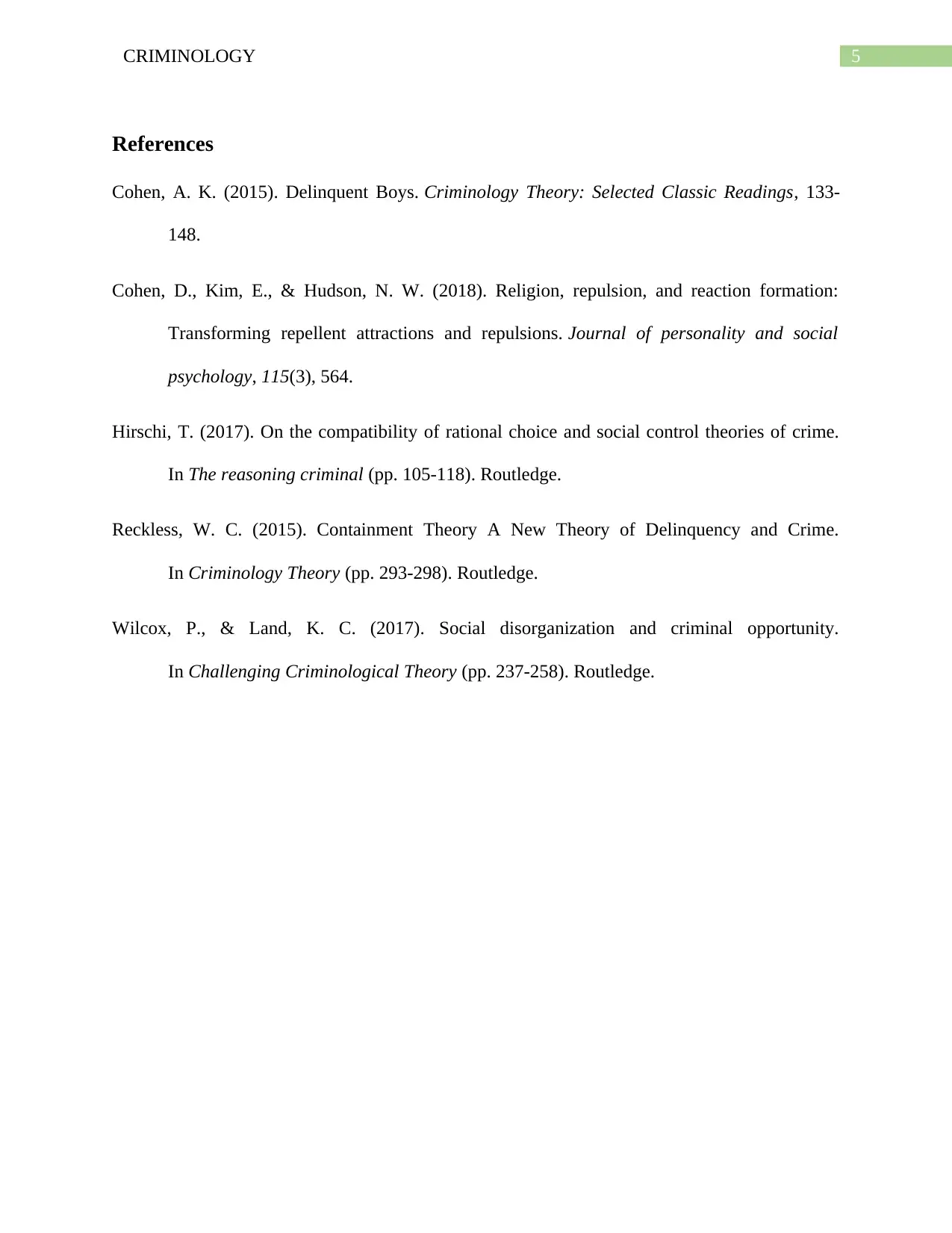
5CRIMINOLOGY
References
Cohen, A. K. (2015). Delinquent Boys. Criminology Theory: Selected Classic Readings, 133-
148.
Cohen, D., Kim, E., & Hudson, N. W. (2018). Religion, repulsion, and reaction formation:
Transforming repellent attractions and repulsions. Journal of personality and social
psychology, 115(3), 564.
Hirschi, T. (2017). On the compatibility of rational choice and social control theories of crime.
In The reasoning criminal (pp. 105-118). Routledge.
Reckless, W. C. (2015). Containment Theory A New Theory of Delinquency and Crime.
In Criminology Theory (pp. 293-298). Routledge.
Wilcox, P., & Land, K. C. (2017). Social disorganization and criminal opportunity.
In Challenging Criminological Theory (pp. 237-258). Routledge.
References
Cohen, A. K. (2015). Delinquent Boys. Criminology Theory: Selected Classic Readings, 133-
148.
Cohen, D., Kim, E., & Hudson, N. W. (2018). Religion, repulsion, and reaction formation:
Transforming repellent attractions and repulsions. Journal of personality and social
psychology, 115(3), 564.
Hirschi, T. (2017). On the compatibility of rational choice and social control theories of crime.
In The reasoning criminal (pp. 105-118). Routledge.
Reckless, W. C. (2015). Containment Theory A New Theory of Delinquency and Crime.
In Criminology Theory (pp. 293-298). Routledge.
Wilcox, P., & Land, K. C. (2017). Social disorganization and criminal opportunity.
In Challenging Criminological Theory (pp. 237-258). Routledge.
⊘ This is a preview!⊘
Do you want full access?
Subscribe today to unlock all pages.

Trusted by 1+ million students worldwide
1 out of 6
Your All-in-One AI-Powered Toolkit for Academic Success.
+13062052269
info@desklib.com
Available 24*7 on WhatsApp / Email
![[object Object]](/_next/static/media/star-bottom.7253800d.svg)
Unlock your academic potential
Copyright © 2020–2025 A2Z Services. All Rights Reserved. Developed and managed by ZUCOL.

